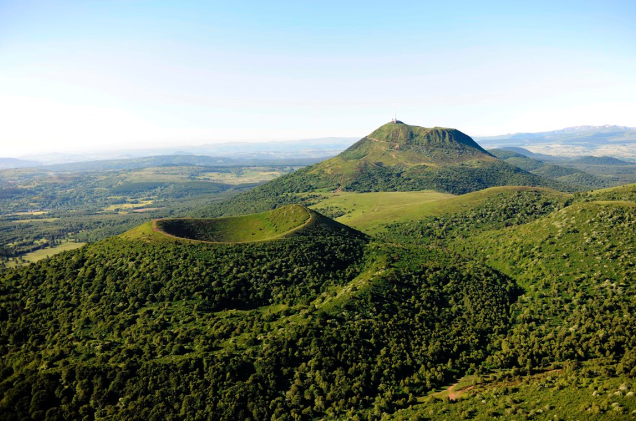Explosive days are not uncommon in the Tour de France. Today’s stage to Puy de Dome might be just that. There are more reasons to consider this ninth stage explosive. It’s time for a volcanic Tour around the region!
Welcome to the highest summit of the Chaines des Puys. We climb to 1465 metres over 13,3 kilometers at a gradient of 7,7%. This park is listed as a UNESCO World Heritage Site since July 2, 2018. The Chaines des Puys is a nearly 40 kilometer-long chain of more than 80 monogenetic volcanoes. It hosts clues of human occupation since the Neolithic. It shows landscape changes related to socio-economical systems inherited from the Middle Ages.

Short but explosive
Monogenetic volcanoes are small and short-lived volcanoes. Hence, once they erupt, their life comes to an end. However, they do not occur alone. Hundreds to thousands of them may group in what we call a Monogenetic Volcanic Field. They erupt one next to another. In this way, each volcano easily becomes extinct over a week or a decade. However a volcanic field may span over thousands to million years. Monogenetic volcanoes reveal structural weakness regions throughout the Earth’s crust. Deep molten rock (magma) uses these weaknessses to rise upwards to the Earth’s surface.
The Chaines des Puys and the Limagne fault is one of those structural weakness regions. They constitute a spectacular natural laboratory to observe a massive tectonic process known as crustal rifting. This means, a continent breakup! Here, long-term tectonics drive mantle upwelling, crustal lifting, thinning and rupture, allowing magma to reach the Earth’s surface through multiple, short-lived volcanic vents. Volcanic activity has been dated between 70 000 and 9000 years ago. This makes it the youngest expression of the French Massif Central volcanism. You can see some of the little volcanoes from the Panoramique des domes.

Going fast or going slow
Monogenetic volcanoes can erupt violently (explosively) or tranquil (effusively) depending on magma viscosity (thickness) and gas content. In cases where enough gas is retained throughout (hot) magma ascent towards the surface, it erupts explosively. It forms little but steep volcanic mountains with craters named scoria or cinder cones. If hot magma encounters (cold) aquifers, a water bearing layer, along its way, the violent magma-water interaction is also an explosive reaction. Instead of building a mountain, it excavates a crater into the ground. Then, a funnel-shaped hole known as maar volcano forms, sometimes hosting lakes.
When magma is gas-poor and viscous (thick) enough to erupt slowly and tranquil, the outflowing lava behaves as toothpaste. It creates a steep mountain plugging the volcanic vent, forming a lava-dome volcano. You are on top of one of them!

Actually, Puy de Dôme is one of the highest (1465m) and largest monogenetic volcanoes (~0.2 – 0.3 km3) along the Chaines des Puys. It called on the attention for ancient spiritual traditions. There are ruins of the Roman temple of Mercury (1st century BCE) built over older archaeological sites. It has been as a sacred location over past human history (Jerram et al., 2017). Also, this is where Blaise Pascal designed his experiment on measuring atmospheric pressure variation with altitude. He defeated the old conceptions about vacuum, making up a true revolution in Physics.
It’s never simple, is it?
The eruption history of Puy de Dôme volcano, however, is all but simple. Field geology and geophysical surveys reveal that the Puy de Dôme volcano formed after several eruptive phases. It combined effusive and explosive activity and included magma-water interaction. The rocky steep slopes, ridges and pinnacles are typical of lava-domes formed by effusive eruptions. The smooth relief downslope reflects loose rocky fragments produced by explosive eruptions. Therefore, this is a pristine locality showing that monogenetic volcanic structures can be superimposed on each other depending on the rising magma evolution and its interaction with the surrounding environment over time.

Phases
Geological mapping attests for an initial phase of magma intrusion into the upper crust, creating a bulge known as the Petit Puy de Dôme (Phase 1). Later on, gas-poor magma was able to outflow and erupt as lava nearly 11,000 years ago. This lava was likely thick and accumulated around the vent building up the main topography of the Puy de Dôme (Phase 2). Then, geologists have found evidence of further intrusions violently disrupting and breaking part of the lava-dome, and producing hot, gravity-laden currents of gas and rock fragments known as Block-and-Ash flows (Phase 3).
Later on, the explosivity of the eruptions increased over time (Phase 4). Some of them resulted from internal magmatic gas overpressure and others involved the interaction of the rising hot magma with surrounding cold aquifers. The last summit eruption occurred after a short quiescence resting phase. This resulted from the explosion of the hydrothermal system sometime around 10,700 years ago, without ejecting magma.

Puy de Dôme is therefore a spectacular example of the complex growth characterising some monogenetic volcanoes. Understood as a multi-stage lava-dome growth, Puy de Dôme provides clues on how very small changes in the amount of melt, crystals-and-gas bubbles size and distributions within magma, changes in pressure and temperature, changes in the mechanism of magma degassing, as well as changes in conduit geometry may induce drastic changes in the eruptive behavior.
Although it is considered an extinct volcano, Puy de Dôme raises the scientific interest on how effusive-explosive transitions occur in similar short-lived systems and drives the awareness of potential hazards expected for communities living on active monogenetic volcanic fields such as in New Zealand, Nicaragua or Mexico. In particular, short eruptions involving the violent explosion of aquifers or the hydrothermal system, as the last one known at Puy de Dôme, commonly lack precursors and are a huge challenge for risk mitigation.
Tranquil explosive days
The unique combination of pristine clues of the geological history combined with archaeological remnants and clues on landscape history, called the attention of Puy de Dôme volcano and the entire Chaîne des Puys as worth of protection and conservation. While you bike, feel the joy of riding across a unique geodiverse spot, a place where the small landforms reveal the beauty of complexity and how inhabitants have interacted with such a stunning volcanic nature throughout history.
Douwe van Hinsbergen went inside the volcano for this stage.






